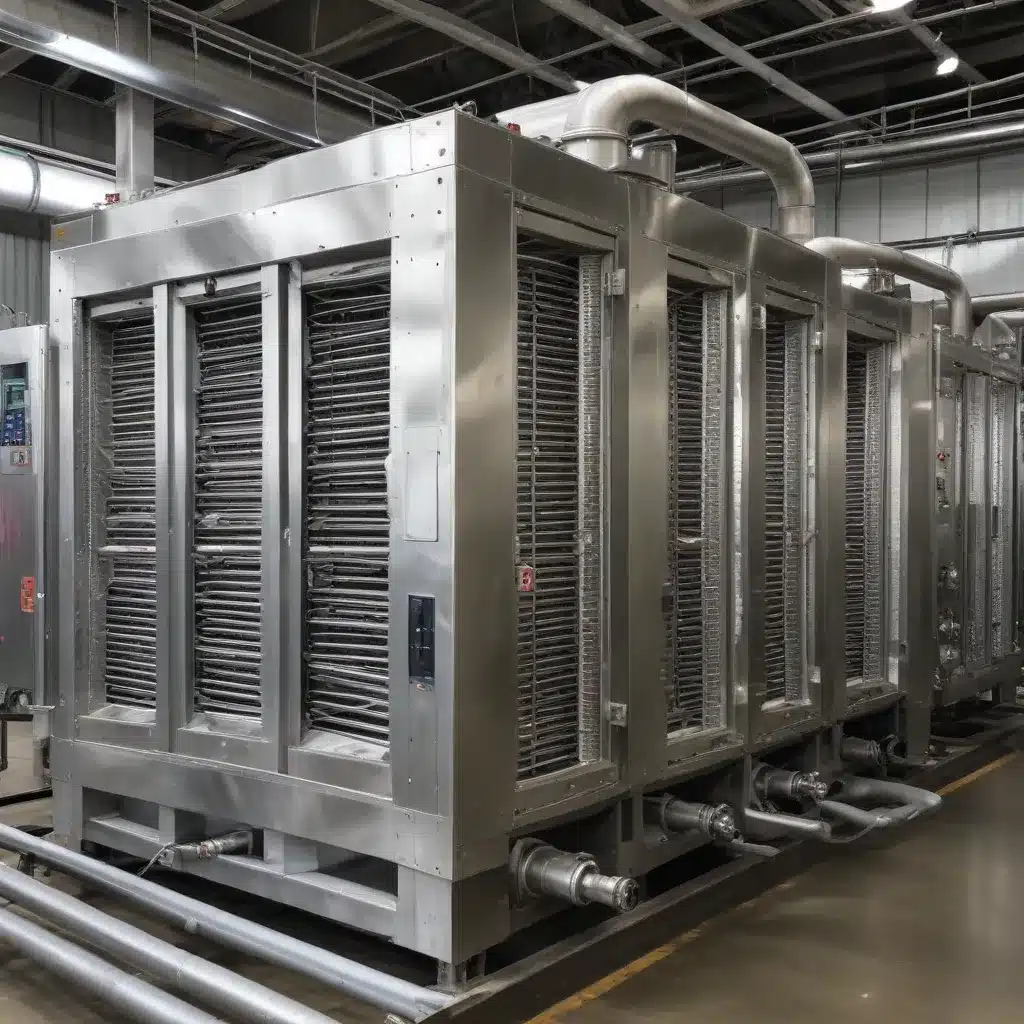
As a seasoned expert in air-cooled heat exchangers, I’m excited to share practical insights and in-depth strategies for optimizing thermal efficiency in the food and beverage industry. Heat exchangers play a crucial role in various industrial processes, and their applications in the food and beverage sector are particularly significant, spanning pasteurization, sterilization, cooling, and more.
Unlocking the Power of Air-Cooled Heat Exchangers
Air-cooled heat exchangers are a versatile and efficient solution for industrial process cooling, especially in water-scarce regions where traditional water-based systems may not be feasible. These heat exchangers transfer heat from a hot fluid to the ambient air, often using strategically placed fans to enhance air velocity and heat transfer rates.
One of the primary advantages of air-cooled heat exchangers in the food and beverage industry is their ability to maintain strict temperature control without the need for large volumes of water. This is particularly important in food processing, where temperature regulation is critical for ensuring product safety and quality. By utilizing air-cooled systems, manufacturers can reduce their water consumption and associated costs, making their operations more sustainable and environmentally friendly.
Enhancing Thermal Efficiency: Design Considerations
When it comes to improving thermal efficiency in the food and beverage industry, the design of air-cooled heat exchangers plays a pivotal role. Let’s explore some key design considerations:
Material Selection
The choice of materials used in the construction of air-cooled heat exchangers can have a significant impact on their performance and longevity. Stainless steel, for instance, is a popular option due to its corrosion resistance and ability to withstand the rigorous cleaning and sanitization requirements of the food industry. Aluminum, with its excellent thermal conductivity and lightweight properties, is also a common choice, particularly in applications where compact design and weight savings are paramount.
Compact and Efficient Geometries
Innovative heat exchanger designs, such as finned tube configurations, can significantly enhance heat transfer efficiency by increasing the surface area available for heat exchange. Plate-type heat exchangers, with their corrugated plate patterns, also offer a compact and highly efficient solution, maximizing heat transfer while minimizing the footprint required.
Advanced Coatings and Treatments
Cutting-edge coatings and surface treatments can further improve the performance and durability of air-cooled heat exchangers. Anti-fouling coatings, for instance, can help prevent the accumulation of dirt, scale, and other contaminants, maintaining optimal heat transfer rates over time. Hydrophilic coatings can also enhance the wettability of the heat exchanger surfaces, promoting efficient heat dissipation.
Optimizing Maintenance and Operations
Proper maintenance and operational practices are essential for maintaining the thermal efficiency of air-cooled heat exchangers in the food and beverage industry. Let’s explore some key strategies:
Regular Cleaning and Inspection
Periodic cleaning of the heat exchanger surfaces is crucial to remove any accumulated fouling, such as dirt, grease, or scale. This not only helps maintain heat transfer efficiency but also ensures compliance with strict hygiene standards in the food processing environment. Regular visual inspections can also help identify any signs of wear or damage, allowing for timely maintenance and repairs.
Monitoring and Performance Tracking
Implementing a comprehensive monitoring system can provide valuable insights into the performance of air-cooled heat exchangers. By tracking key parameters, such as inlet and outlet temperatures, pressure drops, and air velocity, operators can identify any deviations from optimal performance and take proactive measures to address them.
Optimizing Airflow and Fan Operation
Ensuring optimal airflow through the heat exchanger is essential for maximizing heat transfer efficiency. This can be achieved by carefully adjusting fan speeds, maintaining proper air inlet and outlet clearances, and implementing automated control systems to respond to changing process conditions.
Innovative Applications in the Food and Beverage Industry
Air-cooled heat exchangers are finding innovative applications throughout the food and beverage industry, revolutionizing various processes and enhancing overall efficiency.
Pasteurization and Sterilization
In pasteurization and sterilization processes, air-cooled heat exchangers play a crucial role in rapidly cooling hot products to the desired temperatures, ensuring food safety and product quality. Their precise temperature control capabilities are particularly valuable in these critical applications.
Refrigeration and Cooling Systems
Air-cooled heat exchangers are widely used in refrigeration and cooling systems within the food and beverage industry, such as in chiller units, cold storage facilities, and process cooling applications. Their ability to efficiently dissipate heat to the ambient air makes them a preferred choice for maintaining optimal product temperatures and preserving freshness.
Waste Heat Recovery
By incorporating air-cooled heat exchangers into their processes, food and beverage manufacturers can harness waste heat and repurpose it for other applications, such as preheating water or generating steam. This not only enhances overall energy efficiency but also reduces the carbon footprint of their operations.
Conclusion: Embracing the Future of Thermal Management
As the food and beverage industry continues to prioritize energy efficiency, sustainability, and cost-effectiveness, air-cooled heat exchangers are poised to play an increasingly vital role. By leveraging the latest advancements in heat exchanger design, materials, and coatings, industry players can unlock new levels of thermal efficiency, optimizing their processes and driving innovation forward.
At Air Cooled Heat Exchangers, we are committed to empowering food and beverage manufacturers with the knowledge, tools, and strategies to maximize the performance of their air-cooled heat exchangers. By embracing these powerful thermal management solutions, you can enhance process cooling, reduce energy consumption, and stay ahead of the curve in an ever-evolving industry landscape.

